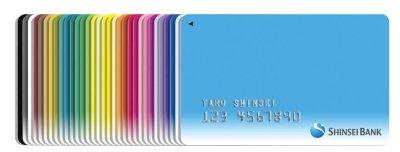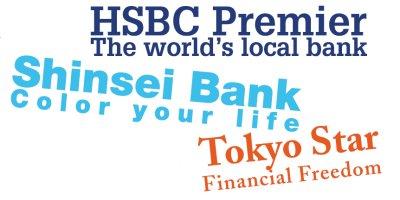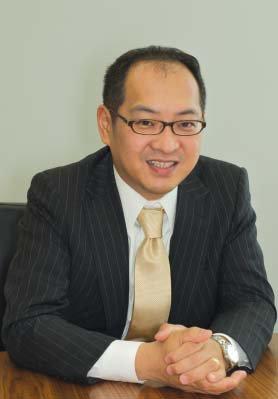Standing out from the Crowd
By Hugh Ashton
How do you shout loudly enough to attract the attention of 120 million customers, with 130 competitors lined up doing the same thing? Especially when some of those 130 are the largest of their type in the world?
This is a challenge faced by retail banks in Japan. Since the realignment of the major nationwide ‘city banks’ into four megabank groups (MUFJ, SMBC, Mizuho and Resona), armed with associated vast marketing budgets, the market can be a hard place, particularly for smaller or foreign institutions.

Some players in this highly contested market have nevertheless made impacts disproportionate to their physical presence, and in this article, we talked to three such banks, each with a non-Japanese connection. Tokyo Star Bank and Shinsei Bank each has a relatively small ‘bricks and mortar’ presence with a multi-cultural management structure, and have achieved a distinctive position in the public’s mind in less than ten years. The third entity is a new player in the Japanese retail market, but an established giant in the rest of the world: HSBC, which launched its HSBC Premier service in Japan this year with considerable success.
One way of attracting customers may seem relatively minor—the color of the bank’s logo and branch design. But for Tokyo Star Bank, the bright orange of the branch design and marketing materials stands out from the usual green, blue and red used by the megabanks, even with only about 30 branches in the Kanto region (36 nationwide). This “gives the customer an impression of warmth” explains Takafumi Igarashi, VP of Marketing. The branch design itself, which differs considerably from the usual Japanese banking facility, also attracts the attention of potential customers. Tokyo Star’s Japanese-sourced interiors are designed to be “casual and relaxing,” Igarashi elaborates, in opposition to a typical Japanese bank’s branch design, or that of some competitors, who tend towards an up-market style that may intimidate some prospective customers. Since Tokyo Star’s main focus is on customer consultation rather than transactions, the ‘coaching booths’ in which Tokyo Star staff members (referred to as ‘Financial Coaches’) provide financial advice to customers, form a key feature of the physical public face of the bank.
Shinsei bank branches (under 40 nationwide, including the innovative minibranch ‘Bank Spots’) achieve the same differentiation from the mass of Japanese ‘dentist’s waiting room’ style bank branches, but add a touch of luxury, similar to a hotel lobby, with carefully chosen color schemes, curves and soft furnishings. The color theme is also picked up in the bank card, where customers are allowed to choose their favorite color, rather than being restricted to corporate styling.
 Tokyo Star Bank
Tokyo Star Bank
What’s in a name?
Branch design is only a part of the branding of the bank and the consolidation of an image in the minds of prospects. Both Shinsei and Tokyo Star are revitalizations (Shinsei’s name actually means “new life”) of older financial institutions that had fallen on hard times (or even suffered from criminal- related scandals). However, Igarashi points out that today’s customers rarely question Tokyo Star’s antecedents, or the bank’s foreign connections. Also assisting Tokyo Star’s public image, is the bank’s CEO, Todd Budge, who is both young (he assumed his post at the age of 43, a babe in arms by Japanese management standards) and fluent in Japanese. This allowed him to make statements directly to Japanese media, going a long way towards differentiating Tokyo Star in customers’ minds.
Shinsei’s predecessor, the Long-Term Credit Bank of Japan (LTCB), was not a retail bank, and its only contact with private individuals was selling debentures. Thus, the problem of previous consumer experience is not so relevant to Shinsei’s retail operations. Although Shinsei’s corporate image suffered a little some years ago as the result of bad debt-disposal issues, this appears to have had no permanent effect on the bank’s standing with its customers, and Shinsei consistently takes the number one or two position in the Nikkei bank customer satisfaction poll. Shinsei’s retail customer base now stands at over 2.2 million, a many-fold increase over the
relatively few wealthy individuals who bought debentures from the LTCB.

HSBC has been in Japan for over 140 years, but mainly providing commercial banking services, rather than a retail operation. Given the full name of the entity (The Hong Kong and Shanghai Banking Corporation Limited), and Japan’s equivocal relationship with China, a few complications might be expected, but according to Minao Kobayashi, Head of Marketing for HSBC’s personal financial services in Japan, this does not happen. “We always use the global brand name of ‘HSBC’,” he explains, “and while we must sometimes use the full name in katakana as required by law, we emphasize the fact that we are a London-based global bank. We don’t see this as any obstacle as far as customers are concerned.” The non-Japanese roots of HSBC also do not affect the perceptions of the more affluent target customer base, who have an increasing level of experience and communication with non-Japanese culture.
Where’s the beef?
But banking is not just about branding, and however clearly a bank differentiates its image in the minds of the public, there must be some steak as well as sizzle for customers to sign on the dotted line. All banks examined here pride themselves on not being mainstream banks and offer services which go well beyond the “take a number and wait in line” attitude of the traditional megabanks.
Shinsei, for example, offers a ‘Shinsei Platinum’ service for customers with assets of ¥3,000,000 (approx. US$30,000) or more invested in certain financial products, or ¥20,000,000 (US$200,000) in assets under management by Shinsei (or a Shinseisourced mortgage). This entitles the customer to certain privileges, including preferential interest rates and access to a financial adviser. Even within the ‘ordinary’ Shinsei PowerFlex accounts, the range of offerings, including multi-currency accounts, and fully bilingual (Japanese and English) telephone, online and mobile services, goes beyond the norm for Japanese banks.
 Minao Kobayashi, Head of Marketing for HSBC’s personal financial services
Minao Kobayashi, Head of Marketing for HSBC’s personal financial services
Full-service Internet banking, compensating for the lack of ubiquitous physical branches, and free 24-hour ATM services were popularized in the Japanese market by Shinsei, leading customers to discover other innovative product available from the bank.
Many of these points were driven by technology, a swamp where the megabank dinosaurs seem to have floundered, and where Shinsei’s new management took a root and branch approach to LTCB’s IT infrastructure. The elimination of bank passbooks and much paperwork by Shinsei is generally welcomed by younger, less conservative bank customers, and Shinsei has even done away with the need for the otherwise ubiquitous personal seal for banking.
HSBC Premier, as the name suggests, positions itself at the higher end of the market— clients wishing to use this service must have ¥10,000,000 (US$100,000) in liquid assets available for banking. In bankers’ terms, these represent the “mass affluent” segment of the market, and HSBC has estimated that there are 6.3 million such individuals in the Greater Tokyo and Osaka areas alone, some 20% of the population. Kobayashi explains that the Premier service is not HSBC’s private banking service (like first class on an airline), but customers enjoy “personalized banking” (business class). HSBC assigns individual Relationship Managers to clients, who become acquainted with a customers’ individual needs and requirements in order to help them with their financial requirements. Each Relationship Manager takes care of a relatively small number of clients, allowing for a personal focus.
Tokyo Star’s Financial Coaches, mentioned earlier, also serve a similar role, getting to know their customers and meeting their financial needs and expectations. Even though Tokyo Star’s customers may be in a different bracket of affluence to those of HSBC Premier, they have needs in common, and Tokyo Star has developed products to assist them.
Igarashi points out that market leadership based on product is fragile, as others may copy or duplicate such products and therefore “superior customer experience” is a key factor. But even so, differentiation based on product innovation is not uncommon.
 HSBC’s personal financial services in Japan
HSBC’s personal financial services in Japan
Specific product offerings—such as Shinsei’s multi-currency structured deposit offerings or its “PowerPocket” overdraft service for mortgage customers, HSBC Premier’s free overseas transfers or Tokyo Star’s mortgage scheme whereby deposits in a savings account may be deducted from mortgage interest payments—are effective means to drive customers to the bank’s other services.
While Shinsei positions itself as a fullservice ‘main bank,’ I.e. Holding the customer’s salary, and used for regular utility payments, etc. (a role traditionally played by the megabanks as a result of economies of scale and entrenched banking habits), HSBC Premier and Tokyo Star see themselves as offering complementary services to those from a main bank. Given Japanese habits related to financial eggs and multiple banking baskets (in 2005, over 520 million bank accounts, including Post Office accounts, were held by a total population of just over 120 million people), the role of a secondary bank is hardly a rarity and is a viable market position.
It is difficult to pinpoint what makes a bank a success in marketing terms, but the common thread of these three success stories in Japanese retail banking seems to be “Think different.” JI
Hugh Ashton is the author of Retail Finance in Japan, published 2008 by VRL Knowledge- Bank, London.
Disclosure of interest: Hugh Ashton is employed by Shinsei Bank, editing internal documents on a part-time occasional basis.





